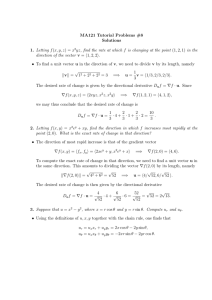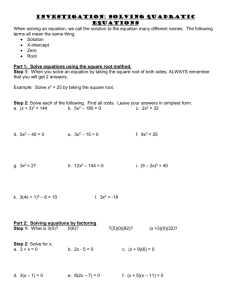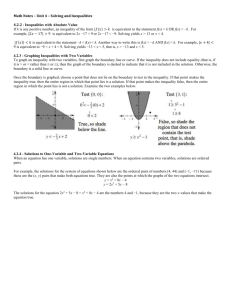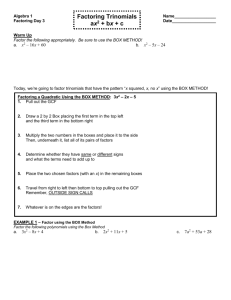MA121 Tutorial Problems #7 Solutions Letting f
advertisement
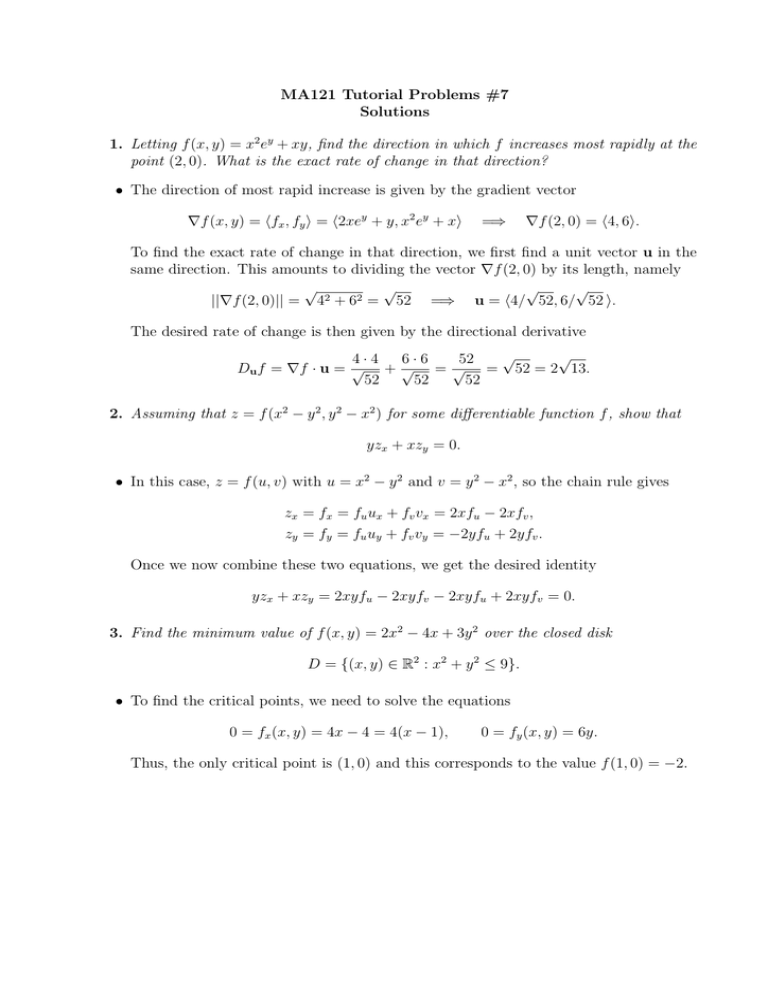
MA121 Tutorial Problems #7
Solutions
1. Letting f (x, y) = x2 ey + xy, find the direction in which f increases most rapidly at the
point (2, 0). What is the exact rate of change in that direction?
• The direction of most rapid increase is given by the gradient vector
∇f (x, y) = hfx , fy i = h2xey + y, x2 ey + xi
=⇒
∇f (2, 0) = h4, 6i.
To find the exact rate of change in that direction, we first find a unit vector u in the
same direction. This amounts to dividing the vector ∇f (2, 0) by its length, namely
√
√
√
√
||∇f (2, 0)|| = 42 + 62 = 52 =⇒ u = h4/ 52, 6/ 52 i.
The desired rate of change is then given by the directional derivative
√
√
4·4
6·6
52
Du f = ∇f · u = √ + √ = √ = 52 = 2 13.
52
52
52
2. Assuming that z = f (x2 − y 2 , y 2 − x2 ) for some differentiable function f , show that
yzx + xzy = 0.
• In this case, z = f (u, v) with u = x2 − y 2 and v = y 2 − x2 , so the chain rule gives
zx = fx = fu ux + fv vx = 2xfu − 2xfv ,
zy = fy = fu uy + fv vy = −2yfu + 2yfv .
Once we now combine these two equations, we get the desired identity
yzx + xzy = 2xyfu − 2xyfv − 2xyfu + 2xyfv = 0.
3. Find the minimum value of f (x, y) = 2x2 − 4x + 3y 2 over the closed disk
D = {(x, y) ∈ R2 : x2 + y 2 ≤ 9}.
• To find the critical points, we need to solve the equations
0 = fx (x, y) = 4x − 4 = 4(x − 1),
0 = fy (x, y) = 6y.
Thus, the only critical point is (1, 0) and this corresponds to the value f (1, 0) = −2.
• Next, we check the points on the boundary of the disk. Along the boundary,
y 2 = 9 − x2
=⇒
f (x, y) = 2x2 − 4x + 3(9 − x2 ) = −x2 − 4x + 27
and we need to find the minimum value of this function on [−3, 3]. Noting that
g(x) = −x2 − 4x + 27
g 0 (x) = −2x − 4 = −2(x + 2),
=⇒
we see that the minimum value may only occur at x = −3, x = 3 or x = −2. Since
g(−3) = 30,
g(3) = 6,
g(−2) = 31,
the smallest value we have found so far is the value f (1, 0) = −2 obtained above.
4. Find the maximum value of f (x, y) = x2 + xy + 3x + 2y over the region
R = {(x, y) ∈ R2 : x2 ≤ y ≤ 4}.
• To find the critical points, we need to solve the equations
0 = fx (x, y) = 2x + y + 3,
0 = fy (x, y) = x + 2.
Since x = −2 by the second equation, we get y = −2x − 3 = 1 by the first equation.
In particular, (−2, 1) is the only critical point, however this point does not lie in the
given region, so we may simply ignore it.
• Next, we check the points on the boundary. Along the parabola y = x2 , we have
f (x, y) = x2 + x3 + 3x + 2x2 = x3 + 3x2 + 3x
and we need to find the maximum value of this function on [−2, 2]. Noting that
g(x) = x3 + 3x2 + 3x
g 0 (x) = 3(x2 + 2x + 1) = 3(x + 1)2 ,
=⇒
we see that the maximum value may only occur at x = −2, x = 2 or x = −1. Since
g(−2) = −2,
g(2) = 26,
g(−1) = −1,
the maximum value is g(2) = 26 and this corresponds to the value f (2, 4) = 26.
• It now remains to check the boundary points along the line y = 4. For these points,
f (x, y) = x2 + 4x + 3x + 8 = x2 + 7x + 8
and we need to find the maximum value of this function on [−2, 2]. Noting that
h(x) = x2 + 7x + 8
=⇒
h0 (x) = 2x + 7 = 2(x + 7/2),
we see that the maximum value may only occur at x = −2 or x = 2. Since
h(−2) = 4 − 14 + 8 = −2,
h(2) = 4 + 14 + 8 = 26,
the maximum value over the whole region is the value f (2, 4) = 26 obtained above.
5. Find the maximum value of f (x, y) = x3 + y 3 − 3xy over the closed triangular region
whose vertices are the points (0, 0), (1, 0) and (1, 2).
• To find the critical points, we need to solve the equations
0 = fx (x, y) = 3x2 − 3y = 3(x2 − y),
0 = fy (x, y) = 3y 2 − 3x = 3(y 2 − x).
These give y = x2 and also x = y 2 , so we easily get
x = y 2 = x4
x4 − x = 0
=⇒
=⇒
x(x3 − 1) = 0
=⇒
x = 0, 1.
Thus, the only critical points are (0, 0) and (1, 1), while f (0, 0) = 0 and f (1, 1) = −1.
• Next, we check the points on the boundary of the region. Along the horizontal side,
y=0
=⇒
f (x, y) = x3
and we have 0 ≤ x ≤ 1, so the maximum value is f (1, 0) = 1. Along the vertical side,
x=1
=⇒
f (x, y) = y 3 − 3y + 1
and we need to find the maximum value of this function on [0, 2]. Noting that
g(y) = y 3 − 3y + 1
=⇒
g 0 (y) = 3y 2 − 3 = 3(y 2 − 1),
we see that the maximum value may only occur at y = 0, y = 2 or y = 1. Since
g(0) = 1,
g(2) = 8 − 6 + 1 = 3,
g(1) = 1 − 3 + 1 = −1,
the largest value so far is the value g(2) = 3 corresponding to f (1, 2) = 3. It remains
to check the boundary points along the hypotenuse. For these points,
y = 2x
=⇒
f (x, y) = x3 + (2x)3 − 3x(2x) = 9x3 − 6x2
and we need to find the maximum value of this function on [0, 1]. Noting that
h(x) = 9x3 − 6x2
=⇒
h0 (x) = 27x2 − 12x = 3x(9x − 4),
we see that the maximum value may only occur at x = 0, x = 1 or x = 4/9. Since
h(0) = 0,
h(1) = 9 − 6 = 3,
h(4/9) = −32/81,
the maximum value over the whole triangular region is the value f (1, 2) = 3.

